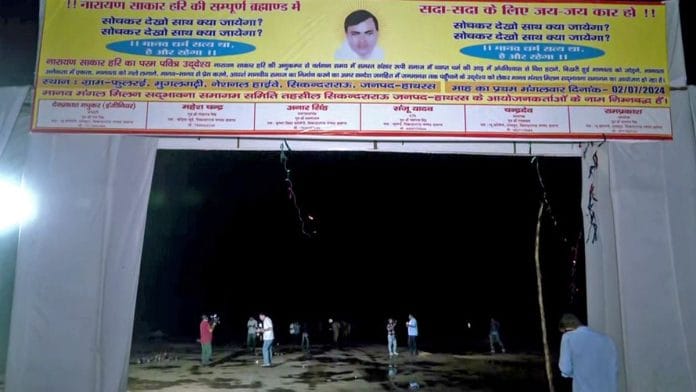Around six to eight years ago, while visiting my native place in Hathras, I witnessed a situation eerily similar to what happened there on 2 July. It was a sweltering May-June afternoon, but the road near the Hathras Junction was completely overtaken by people, mostly women and children.
We had hardly stepped out when a woman approached us, saying, “I am looking for my daughter. She is six years old, have you seen her?” My mother said that she hadn’t and asked her about the crowd.
“Bhole Baba came here for a satsang (religious congregation). People have travelled hundreds of kilometres just to see him,” she replied and went on searching for her daughter.
Worshipped like a god
My mother and I were puzzled. We had never heard of him in our village, which was only 8 km from the satsang’s venue, PC Bagla PG College. After speaking with the people around and looking at the hoardings, we realised he was another baba who was worshipped like a god.
We had to wait for an hour to get an auto to our village. On any other day, this wouldn’t have taken more than a minute. In the chaos of the crowd, my mother saw a familiar face and stopped.
It was a woman in a yellow saree, covered in sweat and trying to find a way out of the packed venue. My mother asked, “What are you doing here, far from home, all by yourself?”
The woman was from the same village as my mother, 20 km from Hathras.
“I heard about this baba in our village and came to see why he is so famous. I must tell you, he has so much wisdom. That’s why people come to see him. But people have no sense of order,” she said, blaming the crowd for the stampede-like situation that day.
“I heard that one or two people have died,” she added.
The satsang was attended by 6,000-7,000 people and the stampede happened as they rushed out of the venue.
Also read: IITian built an AI bot that scored 175 in UPSC prelims. Can change how aspirants study
Crowd control
When I heard about 121 people dying in a stampede at Bhole Baba’s satsang in Hathras on Tuesday, it felt like déjà vu. It brought back memories from all those years ago when I was walking among that sea of people, scared and gripping my mother’s hand. It was terrifying. Having seen the disastrous management firsthand, I can only imagine how frightening it must have been for those who were there.
Bhole Baba is not the only self-proclaimed godman in India. Many babas have held similar gatherings in Delhi like Ram Rahim, Nirankari, or Radha Swami, all of whom can manage crowds efficiently. I don’t believe in going to a baba for peace or solutions to personal problems. But if people attend a baba’s events in large numbers, managing the crowd is the bare minimum of his responsibilities.
In Delhi’s Burari, there is a large ground where thousands gather every year for Nirankari Baba’s satsang. The organisers efficiently manage traffic, parking, and entry-exit points.
In Ram Rahim’s Baghpat Dera, they have a huge space exclusively for bus parking and a network of sevadaars (volunteers) to manage everything from food and water to traffic, parking, and guarding each gate. Sevadaars were present in Hathras but were incompetent at crowd control.
The Hathras incident serves as a reminder of why such gatherings are best avoided. Clearly, Bhole Baba is running his show Ram bharose, placing all responsibility on God’s shoulders.
Views are personal.
(Edited by Prasanna Bachchhav)






